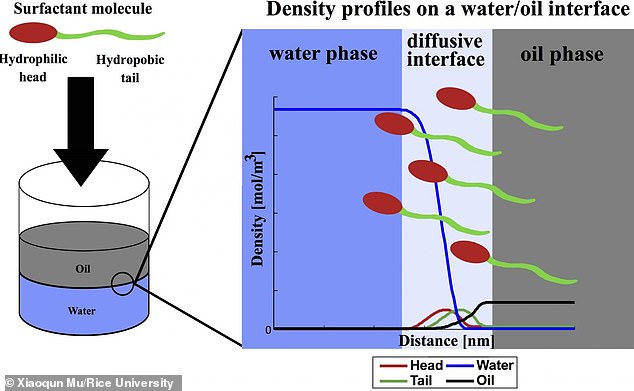If your bath never seems to have enough bubbles, scientists have revealed the biggest mistake you’re probably making.
According to experts, squirting the bottom of your tub with bubble bath before the taps have been turned on is a common blunder.
If you do this, you’re not getting the most from your product and are essentially pouring unused bubble bath down the drain.
Instead, you need to squirt the viscous liquid directly under the tap, but only when the water has started running.
Professor Leif Ristroph, experimental physicist at New York University, said high-pressure water from the taps is an essential ingredient for bubbles.
‘You need to provide a lot of agitation of some kind to whip air through the liquid, which is needed to make lots of bubbles quickly,’ he told the Daily Mail.
If that doesn’t work, scientists have another trick up their sleeve.
While it might sound unusual, experts say that a spoon of baking soda into the bath will boost your bubbles.

You’re running your bath wrong! Scientists reveal the common mistake that could explain your lack of bubbles – and the simple fix to boost the suds
‘If commercial products do not work, try adding some baking soda,’ Roberto Zenit, professor of engineering at Brown University, told the Daily Mail.
Bubble bath seems to miraculously transform from a thick liquid to voluptuous white clouds of foam, but the science behind this process is simple.
These colourful, scented products contain chemicals called ‘surfactants’ that have distinctively-shaped molecules with a water-loving head and a water-repelling tail.
The surfactant molecules push their way between water molecules and in the process separate water molecules from one another.
In this way, the surfactant molecules help spread the water out into a thin film that forms a sphere filled with air.
On a microscopic scale, millions of bubbles are formed like this, which float on the surface because air inside them is lighter than the surrounding water.
Justin C. Burton, professor of fluid mechanics at Emory University, said the ‘real trick’ is getting the water properly aerated.
‘To get the most bubbles, pour the soap in the water stream right after turning on the water,’ he told the Daily Mail. ‘The continued flow will aerate the water and produce lots of bubbles.’

Chemicals called surfactants in bubble bath products have distinctively-shaped molecules with a water-loving head and a water-repelling tail
Adding bubble bath in the right place and at the right time is not the only thing people get wrong, however.
You need to ensure that the pressure of the water is relatively high, so that it blasts powerfully down from the taps rather than falling in a half-hearted drizzle.
Water of a higher pressure agitates the bubble bath solution more intensely, which means more bubbles formed and a greater chance that some still remain by the time you get out.
Another bubble-boosting tip is adding a spoon of baking soda, also known as bicarbonate of soda, into the bath, which reacts to water by producing carbon dioxide gas.
Baking soda is a highly alkaline substance and can relieve irritation and pain from certain skin conditions, but it should not be confused with baking powder, which is a mix of bicarbonate of soda and powdered acid.
Professor Ristroph – who studies soap bubbles in the lab – also suggests adding a little glycerine to the mix for longer-living bubbles.
Glycerine is used in the food industry and also in personal care products to moisturize and protect the skin, but it can add a bit of strength and structure to bubbles so they don’t pop as fast.
Dr David Fairhurst, reader in soft condensed matter physics at the University of Edinburgh, said the hardness of water is another ‘key factor’ – but this depends on location.
In England, ‘hard water’, which has a high mineral content, is common in areas such as Kent, Sussex, Essex, Norfolk and Surrey, while, ‘soft water’ with a lower mineral content tends to be in Cumbria, Lancashire and Yorkshire.
And the harder the water, the fewer the bubbles.
‘The minerals in hard water combine with the soap-like molecules in bubble-bath liquid, locking them away so they aren’t available to stabilise the bubbles,’ Dr Fairhurst told the Daily Mail.
‘You can try adding baking soda to the bath and see if that improves things.
‘Baking soda reduces the acidity of the water slightly which improves bubble lifetime.’
If all else fails, Professor Ristroph suggests an ‘industrialized’ scaled-up version of children’s bubble blowers.
‘Maybe by using a leaf blower or compressed air – then I think things would get very bubbly very quickly,’ he said.
